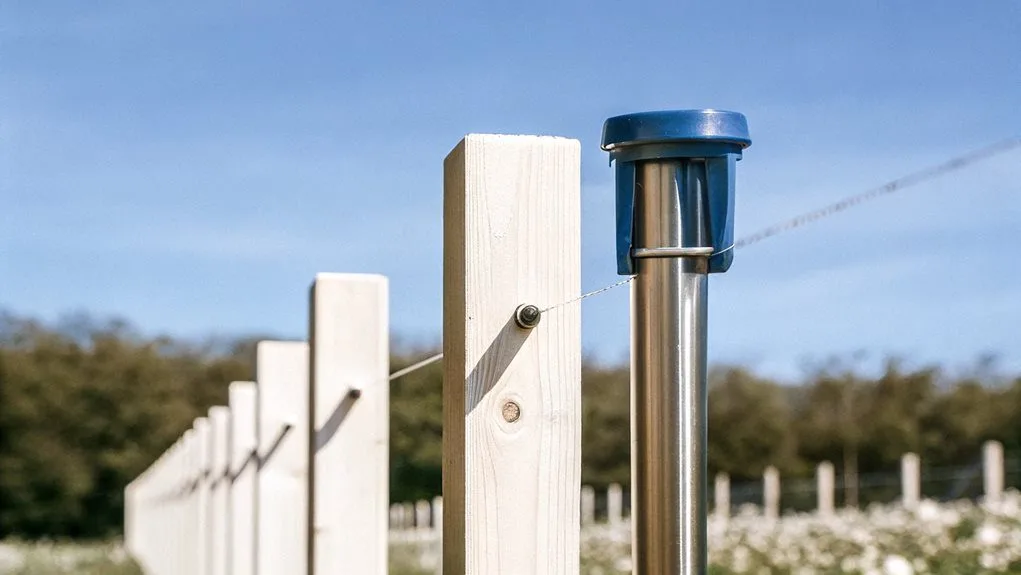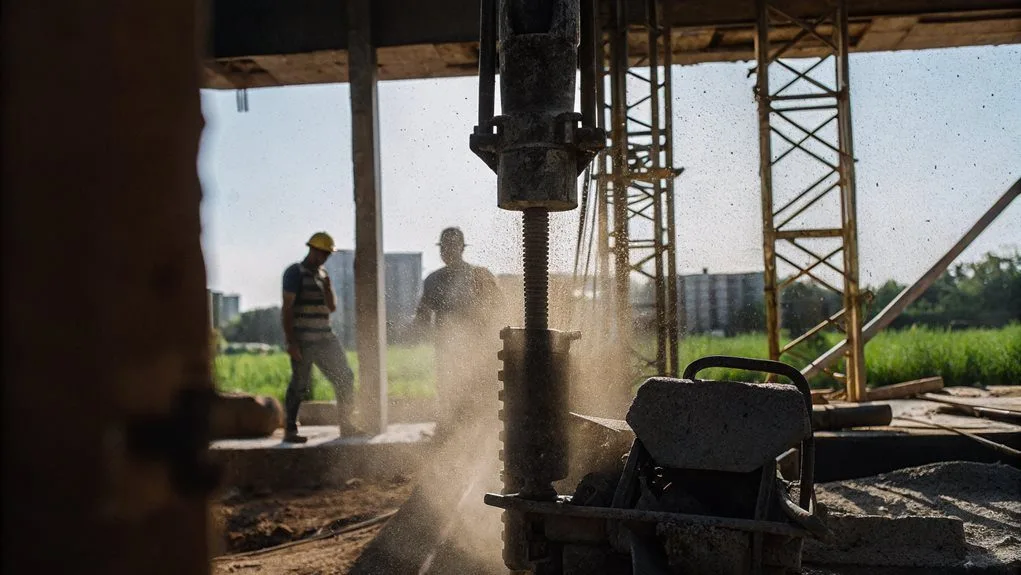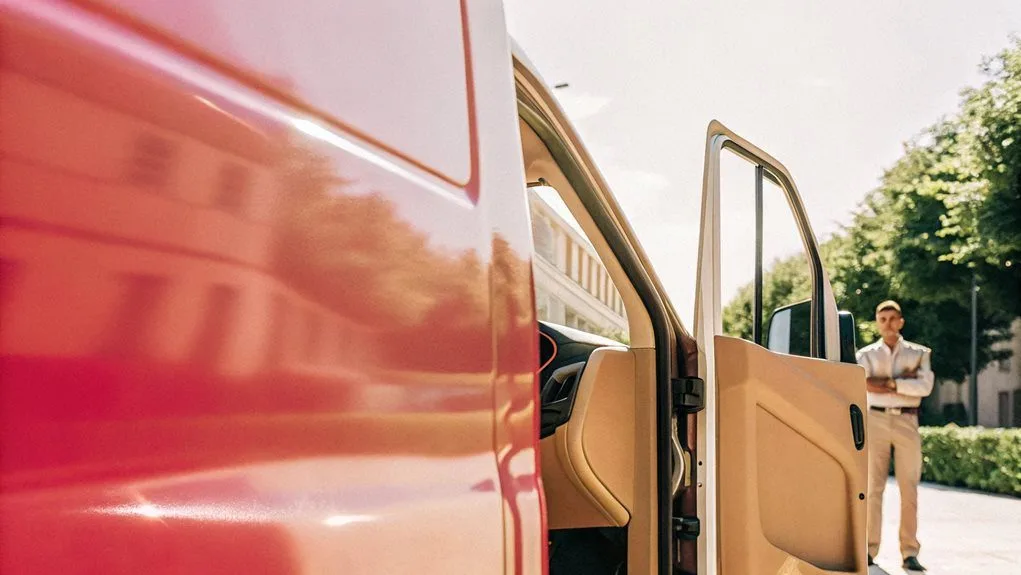Sure, you can operate a plate compactor easily, if you don’t mind getting a bit dirty. This isn’t brain surgery, but if you’ve ever struggled with an IKEA assembly, you might feel a bit out of your depth. Just remember to wear your safety gear, keep an eye out for loose parts, and don’t let it bounce away from you.
Think of it as your new best friend for flattening out that lumpy lawn. Stick around, and you’ll find out more about getting it right.
Key Takeaways
- Plate compactors are user-friendly machines, ideal for DIY projects such as leveling lawns and installing pavers.
- Operators should wear proper safety equipment like glasses, ear protection, and steel-toed boots for safety.
- Basic operation involves a few simple steps: inspecting, starting, adjusting speed, and overlapping passes while compacting.
- Maintenance is crucial; regularly check fluid levels and clean moving parts for optimal performance and longevity.
- With proper guidance and safety measures, anyone can operate a plate compactor effectively for various landscaping tasks.
Understanding Plate Compactors and Their Uses
So, you’re curious about plate compactors, hey?
You’re not alone; these machines are the unsung heroes of construction and landscaping.
These machines are the unsung heroes of both construction and landscaping, ready to tackle any task you throw at them!
They’re not just for the big-shot contractors; you can handle one too!
Think of them as the extroverts at a braai, ready to ramp up the vibes.
With a vibrating metal plate, they compact soil, asphalt, and even prepare ground for your brilliant garden. Unlike rammers, they’re more efficient and cover larger areas—who wouldn’t want that? Additionally, vibrating plate compactors can compress substances like clay and sand effectively.
Moreover, they fall under the category of light compactors, making them ideal for smaller, confined spaces where heavy machinery would be impractical. Plus, those reversible models? Perfect for those tight spaces where you really shouldn’t have tried to fit, but you did anyway.
Just remember, they’re not toys; respect the beast and you’ll get the job done!
Essential Safety Gear for Operation
Regarding operating a plate compactor, you really can’t overlook the essentials—like, say, wearing safety gear. I mean, do you really want flying debris or squashed toes?
Safety glasses are a must; did you know they protect your eyes from all that chaos? And those noise levels? You’ll need ear protection unless you enjoy ringing ears. Molded isolator rubbers are designed to reduce vibration exposure to your hands and arms, so it’s wise to keep that in mind. Additionally, using a plate compactor helps to create a solid base beneath your project, which is another reason to make sure you’re equipped properly.
What about your feet? Steel-toed boots are essential, not just a suggestion! Have you ever tried working without gloves? Good luck with those blisters!
Dust masks are key too, especially if you’ve got a dust cloud following you around. So, put on that gear. It’s not a fashion statement, but it might help you avoid regrettable choices—like a trip to the hospital.
Step-by-Step Guide to Operating a Plate Compactor
Ready to tackle that plate compactor?
First up, check everything out like it’s the last slice of pizza. Is everything secure? Fuel and oil at the right levels? You don’t want a mid-job meltdown!
Next, fire up that beast. Turn the fuel valve, set the choke, and yank the start cord like you mean it!
Once it’s warmed up, adjust the throttle to your comfortable speed. This machine is key to providing the required compaction for your gravel base. Remember, all hire equipment, including the plate compactor, arrives fully checked and serviced for your peace of mind.
Remember, it’s not a race, so don’t fly off the edge. Overlap your passes like you’re doing a cool dance move, and keep a solid grip.
Afterwards, shut it down and let it cool—no one likes a hothead.
Clean it up; it deserves some love too! You’ve got this!
Common Applications for DIY Projects
Regarding DIY projects, plate compactors are basically your best mate—if your best mate could get sweaty and make noise.
Want a solid patio? You’ll need one to lay that level surface. Installing pavers? Yep, compact those base materials if you don’t want shifting pavers ruining your day. Need a retaining wall? Better compact the soil first or face erosion like the dreaded DIY disaster. Gravel driveway? It’s a must for a stable surface; otherwise, you’re just asking for trouble. Levelling your lawn? Say goodbye to that lumpy mess. Plus, using a plate compactor helps achieve smooth, even surfaces, which is crucial for any well-executed project. For larger lawn areas, consider tools like the LUBA2 AWD model that efficiently manage up to 5000 sqm.
Who knew compacting dirt could be so essential, hey? It’s like being the “compactor” of your neighbourhood—everyone appreciates a solid foundation…even if you don’t get the credit.
Maintenance Tips for Long-Lasting Performance
Keep your plate compactor humming along and it’ll pay you back in spades. Seriously, who wouldn’t want their tool to last longer?
Before you fire it up, inspect for cracks and tighten loose parts.
Inspect your plate compactor for cracks and tighten any loose parts before use to avoid mid-job surprises.
No one likes surprises, especially not mid-job.
And fluid levels? Yeah, check those too. It’s like feeding your pet—so much trouble if you don’t!
In the long run, clean debris and grease those moving parts regularly. Think of it as a spa day for your compactor.
And don’t forget change those filters; nobody wants a grumpy machine.
Finally, store it safely—no one wants a rogue compactor wreaking havoc.
Conclusion
So, can you operate a plate compactor easily? Sure, if you like to feel like a heavy-duty construction worker for a day! With some basic know-how and a bit of safety gear—because, let’s be real, you don’t want to end up as a meme—you’ll be flattening that soil like a pro. Just remember, it’s not a toy, and you can’t just wing it. Follow the guide, and you’ll be saying goodbye to those bumpy surfaces before you know it!






